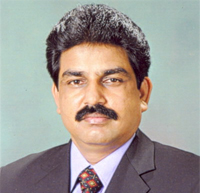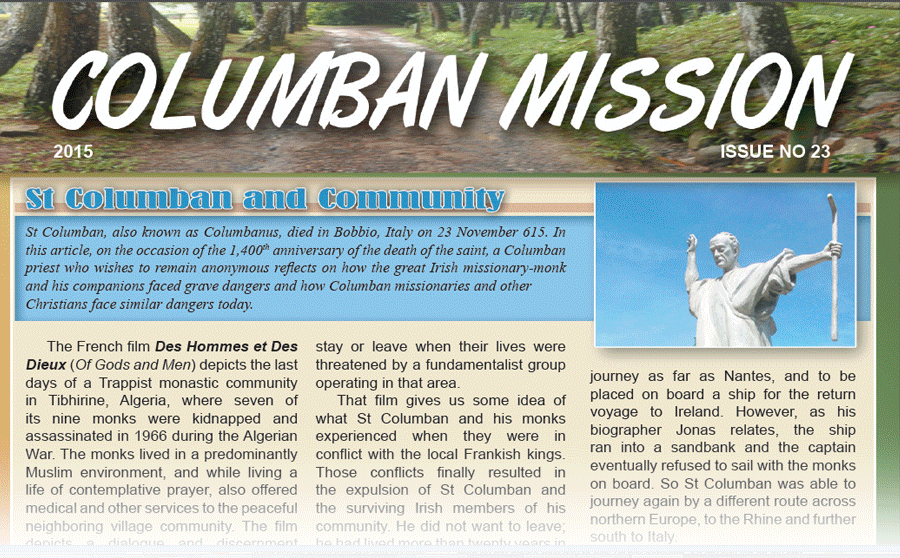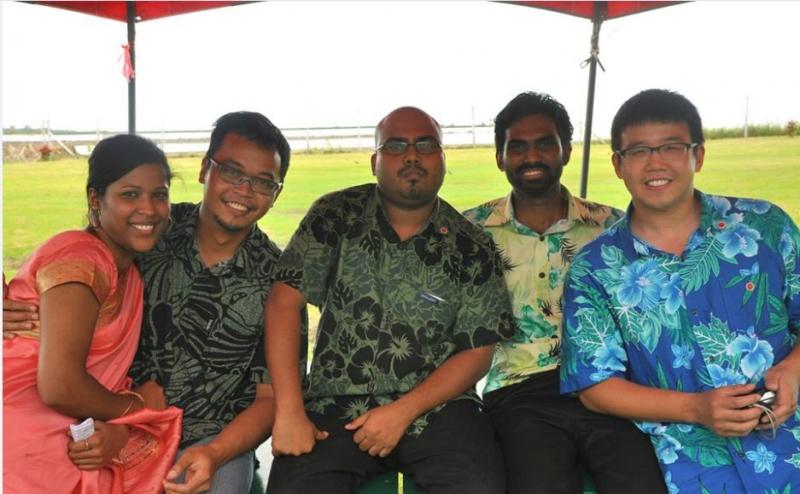Misyon Online - March-April 2014

Shahbaz Bhatti شہبازبھٹی
(9 September 1968 – 2 March 2011)
‘I want to live for Christ and it is for Him that I want to die.’
The Church in the Philippines is engaged in a nine-year preparation for the celebration in 2021 of the 500th anniversary of the arrival of Christianity in the Philippines in 1521. The first year of that preparation was the Year of Faith, 2013, observed throughout the world at the initiative of Pope Benedict XVI. The bishops of the Philippines have declared 2014, the second year of preparation for the celebration in 2021, as the Year of the Laity in the country.
Pope Francis in his apostolic exhortation Evangelii Gaudium, The Joy of the Gospel (EG), calls each one of us to share that joy with others.
|
|
Back from Fiji, Part IIThe first part of this interview by Anne B. Gubuan, assistant editor, of Kurt Zion Pala appeared in the September-October issue of Misyon. Kurt is a Columban seminarian from Iligan City who last year completed his two-year First Mission Assignment in Fiji. He resumed his studies in theology last June. From what you’re saying, Fiji seems peaceful, with ‘unity in diversity’ and no conflict.
On the surface it’s peaceful. But you can feel the tension between the two cultures. You hear people’s biases, for example, ethnic Fijians saying that Indo-Fijians are ‘too frugal’. It’s like what I have experienced in Mindanao, between Christians and Muslims. But in Mindanao, everything is expressed, people fight. In Fiji, it’s a bit more repressed as people won’t discuss the situation among themselves.
|
|
|
In Prison in PeruBy Fr Noel Kerins Columban Fr Noel Kerins was ordained in Ireland in December 1965 and has spent most of his priestly life in Peru.
It was a hot and humid day. The jail is isolated and surrounded by sand. The prisoner's name was Peter; he was 22-years-old. I asked him his name, but he looked at the ground. His face was sad. He had just been baptized; his mother and sister had arrived for the ceremony. I had embarrassed him by asking for his father's name. In Peru, I would be called Noel Kerins Fitzgerald: both my father's and my mother's surnames are included. When Peter responded ‘My father never recognized me’ he suffered a double loss of face. He had only one surname, and now he had lost his honor, admitting that he was illegitimate, and that in front of a foreign priest.
|
|
|
Mission LimasawaBy Fr Hector Suano It was about ten in the morning and the sky was gray when I descended from the road to the shore. The sight and sound of big waves lashing the shore opened before me and the strong cold wind blowing against me made me adjust my feet for greater balance and stability. Beyond the waves not far away in the distance, I saw my destination island, emerald in color against the washed-out horizon. Knowing that boats would not travel in this stormy weather, I gave up my plan to visit it that day; crossing the sea was simply ‘Mission Impossible’.
The day before, I had gone to see Bishop Precioso D. Cantillas SDB of Maasin. I told him that I was interested in visiting a mission area of his diocese. He suggested Limasawa Island. You would never think that after almost 500 years of Christianity in the Philippines, Limasawa Island, where the first Mass was celebrated, would still be a mission area. But, for whatever reasons, this historic island remains very much a mission destination today.
|
|
Rattno's StoryFr McCulloch, an Australian, worked in Mindanao from 1971 till 1978 when he was assigned to Pakistan, a new mission for the Columbans. He spent 34 years in Pakistan and in 2012 was given that country’s highest civilian award for foreign nationals. He is now in Rome as the Procurator General of the Columbans.
Unlike three other children in his family, 12-year-old Rattno was lucky to survive in November 2012 when the shack their family called home burnt down. Rattno is a Hindu boy of the Parkari Koli tribal people in south-east Pakistan who are desperately poor, enslaved to feudal Muslim landlords, dispossessed, and who lost everything they had during the floods of 2010 and 2011. Rattno's parents moved to Jhirruk, 40km south of Hyderabad, when they heard that St Elizabeth Hospital was building houses to re-house flood affected people. Although the hospital had constructed 820 houses in other places, only 30 could be built in Jhirruk until more funds became available.
|
|
|
Tears and Light in JuarezBy Fr Kevin Mullins
Some time ago drug-cartel soldiers visited a house near our parish church. The man of the house was a small-time drug-seller and user. Reportedly he had not paid up on time. The cartel soldiers forced him and his three-year-old daughter to watch as they slit his wife’s throat. Then the child watched as they shot half her father’s face away and left him for dead. The little girl lay for nine hours on the legs of her dead parents and then, in the morning, went outside to let neighbors know that something was wrong. The violence of the drug cartels in our city is endemic but, for the cartels, it is a means to an end. They prefer their business to be free of violence and so use bribes to encourage collaboration from politicians, police chiefs, state governors, mayors, etc. These are often offered a choice: plata (money) or plomo (lead ie, a bullet).
|
|
|











 The author is a Columban from Brisbane, Queensland, Australia, who has worked in Chile and in Britain. For the past fifteen years he has been in Corpus Christi
The author is a Columban from Brisbane, Queensland, Australia, who has worked in Chile and in Britain. For the past fifteen years he has been in Corpus Christi